Nutritional strategies to meet the challenge of a fast changing poultry market
In 1999, restrictions on the use of prophylactic antibiotic growth promoters (AGPs) in animal feed began in all European Union countries. This ban affected poultry producers in EU and also in countries that are exporting poultry products to this region. The growing focus on production of ‘natural’ as well as ‘organic’ poultry in other markets make this topic relevant and potentially profitable to the industry everywhere.
For the EU poultry industry, the removal of growth promoters has typically resulted in increased cost of production but also in reduced performance coupled with reported reduction in litter quality and increased potential for carcass microbial contamination.
The last year’s published procedures regarding the use of some ionophorous anticoccidials in EU suggest that the legislative changes affecting poultry feed and production continue and producers need to adapt quickly to maintain or even better to improve the profitability.
Different strategies, combining nutrition and management, have been implemented to cope with the reported negative side effects of in-feed antibiotic withdrawal. The situation also fuelled an interest in research to evaluate new sustainable approaches of poultry production.
Commercial and scientific evidence suggest that some commonly used feed additives such as exogenous enzymes and betaine combined with changes in management may potentially offer considerable improvements in poultry production economics.
However other means such as vaccination, use of microbial cultures, prebiotics, organic acids, plant products, feed ingredients, fat sources, feed technology and management are also being considered.
The benefits of AGPs and ionophorous anticoccidials
Antibiotic growth promoters have a long history of prophylactic use in animal feed, wherein they contributed to improved animal performance and health status.
While the mode of action of antibiotic growth promoters is not fully understood, it is believed that the main effects are mediated via the bacterial gut flora (Gaskins et al., 2002) by targeting and destroying the select types of intestinal microflora.
In-feed anticoccidials have been approved primarily as anticoccidial agents, however, the difference between antibacterial and anticoccidial compounds has never been clear-cut (Kaldhusdal, 2003). The long-term benefit of AGPs has been seen in improvement of growth, health and performance uniformity.
However, the size of performance response to AGP’s will depend on farm management, exposure to pathogens, environmental stresses and diet type. In separate papers, Rosen (2003) and Thomke and Elwinger (1998) reviewed a large number of studies to document the effect of these factors on AGPs activity. They suggested that, on average, AGP products improve FCR by approximately 3%.
For a broiler at 42 days of age, this means an average FCR improvement of 5-6 points. Although this allows for calculation of the economic loss anticipated with AGP withdrawal, this does not account for the additional potential losses due to increased mortality, performance variability and increased contamination in the processing plant.
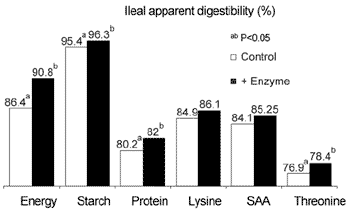  |
| Figure 1: The effect of enzyme supplementation on nutrient digestibility and performance of broilers fed corn/soy diets. |
Nutrition of intestinal microflora
The nutrition of bacteria in the intestine ultimately comes from the diet fed to the chicken. Wagner and Thomas (1997) found that the type of ingredients included in a diet affected microbial populations present in gastrointestinal tract.
Physiological factors such as pH in the gizzard/proventriculus, grinding action of the gizzard, feed particle size, presence of digestive enzymes, high oxygen tension, and endogenous antimicrobal compounds such as bile salts help limit microbial proliferation in the small intestine. However, further along the digestive tract the environment becomes more favourable for bacterial growth due to reduced oxygen content and presence of unabsorbed but available/fermentable substrate.
 |
| Figure 2: The effect of exogenous enzymes on microbial populations. |
When digestion and abso rption are optimal and endogenous losses are minimal, there is limited substrate left that can be rapidly digested (e.g. starch, protein) by the resident microflora of the GI tract to fuel their growth.
Conversely, reduced nutrient digestibility to the bird typically occurs when feeding less digestible feed ingredients (Vahjen et al., 1998) or in the presence of gut lesions caused by coccidiosis or other enteric disease challenge. The unabsorbed nutrients provide easily fermentable substrate for microbial proliferation in upper and lower gastrointestinal tract.
Campylobacter jejuni and most types of Salmonella infections primarily imply a health risk to consumers of poultry. Other bacteria cause concern because they induce intestinal disease in the birds.
Among the most gut-specific pathogens Clostridium perfringens is assumed to represent the main health problem associated with an abolished use of in- feed antibiotics. However, both groups of bacteria follow the same pattern of nutrition as explained above.
Sustainable approaches to reduce potential problems
Increased demand by consumers for wholesome and safe poultry products that are produced to the highest standards including bird welfare, hygiene, environment and reduction in ‘drug’ usage (AGPs, ionophorous anticoccidials) has resulted in shifts in poultry production and management.
Removal of growth promoting antibiotics and anticoccidials can impact performance and production economics through emerging enteric diseases such as necrotic enteritis. European poultry producers have been evaluating alternative ways of correcting for performance and mortality losses associated with AGP withdrawal.
In general, it has been found that a combination of different approaches is required in order to compensate for the performance and economic losses associated with AGP withdrawal. It is recognised that the risk of microbial contamination through feed or house environment must be reduced to a minimum through practices such as greater attention to improved litter quality, sanitation and feed and farm biosecurity.
Not all these changes, however, are able to fully prevent a rise in bacterial proliferation in poultry GI tract by themselves. In addition to poultry production/management based preventative measures, nutritional strategies are employed.
Use of highly digestible feed ingredients limit the ‘bypass’ of nutrients from the host to the microflora. However, this approach can be expensive due to the high cost of ingredients with highly digestible nutrients. Another nutritional approach is to incorporate feed additives that are effective in improving nutrient digestibility of the diet and in turn may alter nutrient supply available to the microflora.
Among feed additives, exogenous enzymes have been used commercially for approximately 15 years to improve nutrient digestibility, performance and body weight uniformity in poultry fed wheat/barley-based diets. More recently, exogenous enzymes have also shown value in improving performance and nutrient availability in corn/sorghum/soybased diets (Figure 1).
Apajalahti and Bedford (1999) reported that exogenous enzymes can play a role in influencing gut microbial populations in broilers fed wheat-based diets (Figure 2). Choct et al.(1999) noted that the effects of certain antinutritional factors (e.g. soluble non-starch polysaccharides) could contribute to changes (types and levels) in gut microflora.
The relationship between the use of enzymes in wheat- and corn-based diets and their indirect effect on microbial proliferation has been recently evaluated in series of studies at Bristol University in UK.
In one study, broilers were inoculated with Salmonella enteritidis at 4 days of age and were fed diets supplemented with or without a mix of xylanase, protease and amylase (Avizyme® 1500). At 17 days of age, the level of Salmonella in the cecum of the enzyme-supplemented group was reduced by 80% (Figure 3) compared to the group without the enzyme.
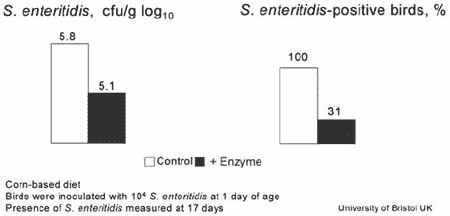 |
| Figure 3: The effect of enzyme supplementation on Salmonella enteritidis reduction in cecum of broiler fed corn/soy-based diets. |
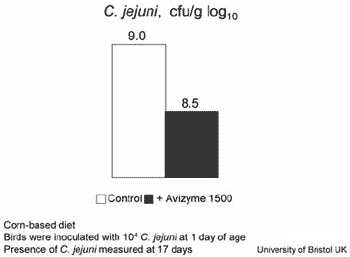 |
| Figure 4: The effect of enzyme supplementation on Campylobacter jejuni reduction in cecum of broiler fed corn/soy-based diets. |
Similar responses were also found with Campylobacter jejuni (Figure 4).
Fernandes et al (2000) has also seen similar results in wheat-based diets.
Exogenous enzymes improve availability of nutrients in feed ingredients to the host but they also can impact level and profile of bacteria by affecting the amount and type of substrate available to the microflora. An example would be an improvement in a carbohydrate profile preferred as a substrate by beneficial microflora such as Lactobacillus.
Other feed additives can impact performance and nutrient digestibility through indirect mechanisms. The removal of AGPs often increases the incidence of enteritic diseases such as necrotic enteritis (NE). Elwinger et al (1998) suggested that NE often follows coccidia challenge.
Feed additives such as betaine (Betafin®) that help reduce lesion damage associated with small intestinal coccidia also show improvements in bird performance and nutrient digestibility when supplemented in the presence of coccidia challenge (Table 1).
Improvements in intestinal integrity result in better nutrient digestibility (Figure 5). Due to the ability to improve intestinal integrity and subsequently nutrient absorption during coccidia challenge, betaine indirectly reduces nutrient supply to gastrointestinal microflora. In feed formulation, betaine can be used to spare methionine and choline to reduce feed cost.
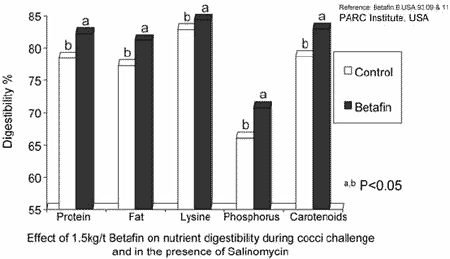 |
| Figure 5: The effect of Betafin on nutrient digestibility improvement in coccidia challenged broilers. |
Other approaches such as feeding undefined and defined (probiotics) microbial cultures or products that supply nutrients for beneficial microflora (prebiotics) or products such as organic acids, plant products, feed ingredients, fat sources, feed technology and management are being considered by commercial industry. This area is very exciting and may offer commercial value, however, exploration of these products has only just started. Of the feed additives mentioned above, only enzymes and betaine can be formulated into the feed to reduce cost while generating the above mentioned effects, either direct or indirect, on gastrointestinal microflora.
| Table 1: The effect of coccidia challenge and betaine supplementation on the crypt-villus ratio in small intestine of broilers (Kettunen et al., 2002). |
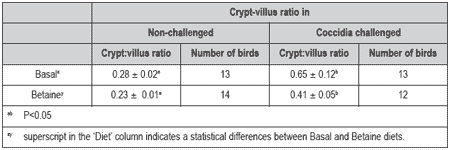 |
| Conclusions Currently, the feed and animal production industry is facing a number of challenges, not the least of which are the pressures to produce high quality products to satisfy customer needs in a cost effective manner. The industry is facing a future without the benefit of some biologically and economically effective feed additives such as AGPs and ionophorous anticoccidials. Solving the puzzle of feeding poultry without prophylactic use of antibiotic growth promoters and effective anticoccidial agents requires further research and evaluation. Nevertheless, it is clear that the causes of microbial proliferation, especially of pathogenic bacteria, must be reduced to minimum either via improved management practices or via currently available nutritional means. As examples, exogenous enzymes and betaine can contribute significantly to a replacement strategy of AGPs and anticoccidial agents, by altering the nutrient supply to intestinal microflora and by improving intestinal integrity of the bird. Both ingredients offer potential to reduce diet cost and improve broiler performance in AGP free diets. |
References
Apajalahti, J., and Bedford M. R., 1999. World Poultry, 15 (2). Choct, M., Hughes, R. J., and Bedford M. R., 1999. British Poultry Science, 40:419- 422.
Elwinger, K., Berndtson, E., Engstrom, B., Fossum, O., and Waldenstedt, L., 1998. Effect of antibiotic growth promoters and anticoccidials on growth of Clostridium perfringens in the caeca and on performance of broiler chickens. Acta Veterinaria 39: 433 – 441.
Fernandez, F., Sharma, R., Hinton, M., and M. Bedfrod, 2000 Diet influences the colonisation of Campylobacter jejuni and distribution of mucin carbohydrates in the chick intestinal tract. Cell. Mol. Life Sci. 57: 1793 – 1801.
Gaskins, H. R., Collier, C. T., and Anderson, D. B. (2002). Antibiotics as growth promotans: Mode of action. Animal Biotechnology 13: 29-42.
Kaldhusdal, M., 2003. Maintaining gut health in meat-type poultry without antibacterial growth promoters and ionophores. WPSA, Lillehamer, Norway. Agust 2003.
Kettunen, H., K. Tiihonen, S. Peuranen, M.T. Saarinen and J. C. Remus, 2002. Dietary betaine accumulates in the liver and intestinal tissue and stabilizes the intestinal epithelial structure in healthy and coccidia-infected broiler chicks. Comp. Biochem. Physiol. 129.
Rosen, G.D. (2003). In Gesunde Nutztiere. Heutiger Stellewert der Futterzusatzstoffe in der Tierernaehrung. Tagungsbericht 15. Mai 2003. Editors, M. Kreuzer, C. Wenk and T. Lanzini. Band 24, Schriftenreihe aus den Institut fuer Nutztierwissenschaften, Ernaehrung- Produkte-Umwelt, ETH-Zentrum, CH- 8092 Zuerich. 72-88.
Thomke, S., and Elwinger, K., 1998. Growth promotants in feeding pigs and poultry. II Mode of action of antibiotic growth promotants. Annales de Zootechnie 47:153-167.
Vahjen, W., Glaser, K., Schafer, K. and Simon, O., 1998. Influence of xylanasesupplemented feed on the development of selected bacterial groups in the intestinal tract of broiler chicks. Journal of Agricultural Science, Cambridge 130: 489 – 500.
Wagner, D. D., and Thomas, O. P., 1997. Influence of diets containing rye or pectin on the intestinal flora of chicks. Poultry Science 57: 971- 975.
Authors: M. Hruby, J.C. Remus, and E. Ernest M. Pierson
Danisco Animal Nutrition, P.O. Box 777, Marlborough, Wiltshire, SN8 1XN, United Kingdom
 | The previous article is a special collaboration from AFMA South Africa |
Good article about changing in poultry market. There are totally natural solutions available as e.g.
The Plocher Energy Technology (Penac Products, Organic Farm & Garden Supplies, sole agent for Southern Africa and beyond) has in many countries proven its effectiveness also with its animal feed additive. This technology seems to prevent and/or clear the intestines of parasites and other undesirable anaerobe microbes thus stabilizing the animals health, performance and production. Numerous trials in various countries have shown that with this additive same and often better results are achieved without the use of AGPs.
The litter is aerobe (application 50g/t feed for broilers, 50g/t feed for layers, ducks etc.), thus methan free astmosphere in the housing, no flies, no dung beetles etc. which again results in better meat, milk, eggs, wool, hoof etc. quality. Often the drinking water is not the quality it should be - then the Water Kat should be attached. These Kats need no specific installation but are simply clamped to the water pipe, never come in contact with the water itself, do not need any outside power such als electricity, nor do they work with a magnet. Their life span is not known yet as the first Kats are still working and that since about 25 years without any problem. It maybe the most inexpensive and effective way of stabilizing ground, surface and waste waters totally naturally and thus environmental friendly. The German Ministry for Economic and Cooperation and Development has released a report on viable future technologies such as the Plocher Energy Technology. Through the implementation of this technology any natural process can be enhanced or lets rather say proper balance is re-established be it in agriculture or any stock farming, horse racing and jumping etc., waste management as e.g. aerobe liquid or dry fertilizer from all excretia, fresh or contaminated waters etc. Of course the technology and its products are registered and comply to the rules and regulations of EU, FDA, FAO etc. for organic farming. Scientific and other reports are available.
We must reduce and where possible avoid chemical substances - Plocher makes provision for both.
I am working with these products for more than 12 years and never had a negative effect - the system does not provide for any negative or damaging outcome.
However South Africa is a very difficult country for the implementation of new technologies as the the Plocher Energy Technology due to the fact that until only a few years ago there were never any teachings regarding natural ways to go but only chemical solutions were provided thus the industry had difficulties adapting or even understanding futuristic technologies. One can only hope that this will soon be a thing of the past. A further problem is the fact that SA to this day has no proper laws in place as e.g. the use of AGP etc. But SA must adapt to the EU etc. and if it is only because of exporting its goods but also to combat deteriorating food quality, allergies, the growing number of people looking for food containing lessor chemical residues (not even MSG is prohibited) , an ever increasing number of people wanting to buy organic products (bio), cancer and AIDS sufferers being told to eat organic food as this will prolong their lifes (but they can hardly find it). Anyone being interested to learn more and implementing this technology is welcome to contact us.










.jpg&w=3840&q=75)